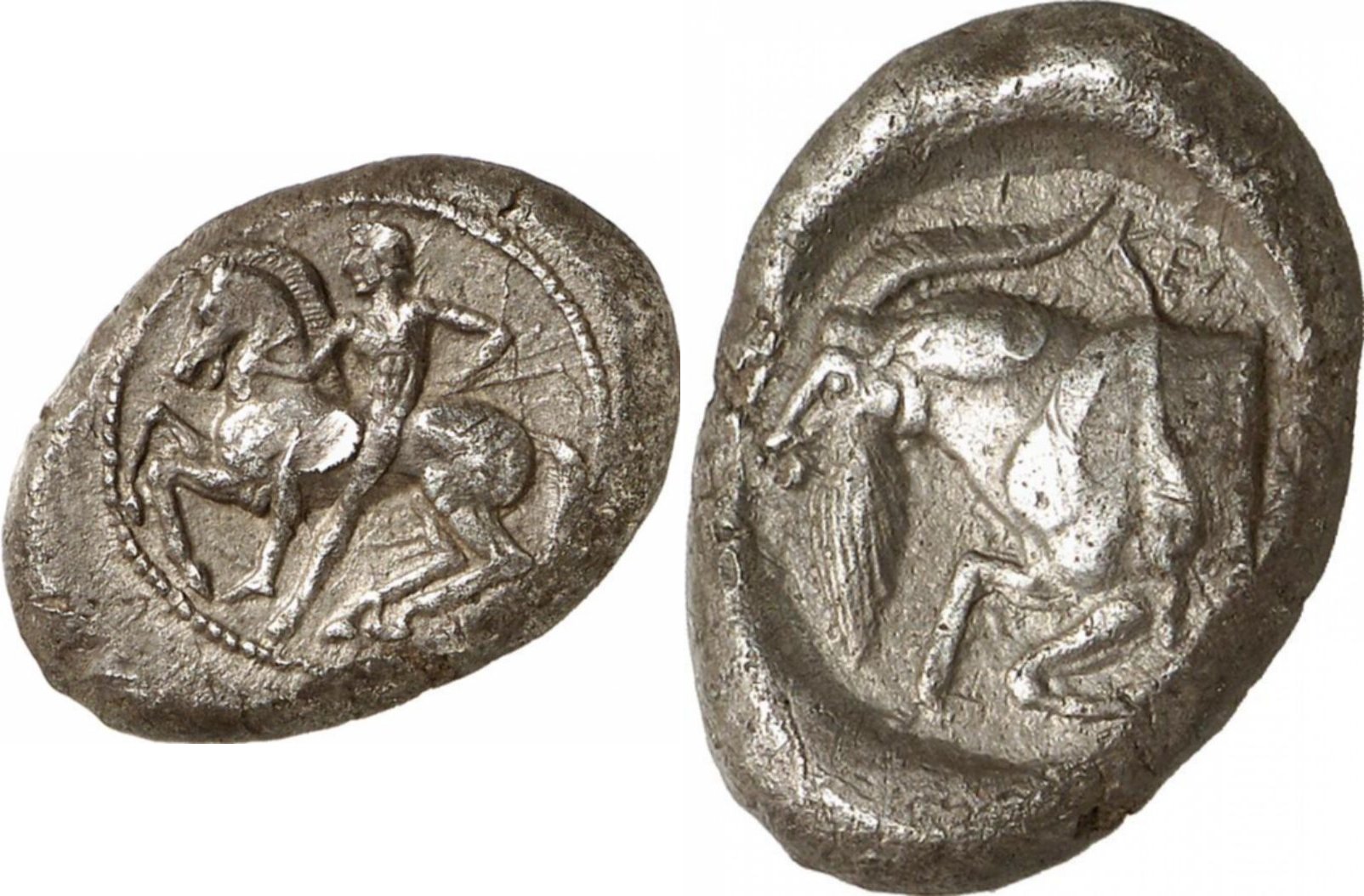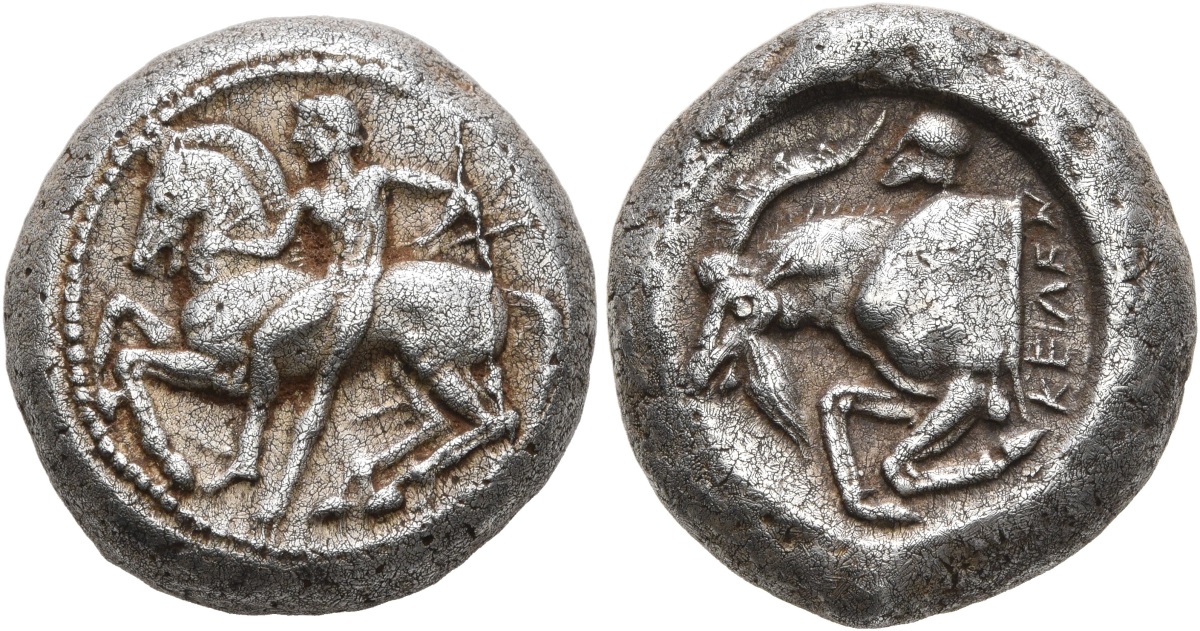| Type 1.1 | |
| Denomination: | AR Stater |
| Obverse: | Youthful nude rider, holding reins in right hand and whip in left, dismounting from horse rearing to left; dotted border. |
| Reverse: | Forepart of goat kneeling to left; above goat, KEΛ; all within circular incuse. |
| References: | SNG Levante, 17 = Baldwin’s Auctions Ltd, Auction 37 (4 May 2003), Lot 699 (acsearch.info URL); Gorny & Mosch Giessener Münzhandlung, Auction 169 (12 October 2008), Lot 133 (acsearch.info URL) |
| Die links: | Type 1.2 (obverse) |
| Credit: | Gorny & Mosch Giessener Münzhandlung (see the references above) |
| Remark: | Both cited specimens are from the same obverse and reverse dies. The obverse die is shared with Type 1.2. |
| Type 1.2 | |
| Denomination: | AR Stater |
| Obverse: | Youthful nude rider, holding reins in right hand and whip in left, dismounting from horse rearing to left; dotted border. | |
| Reverse: | Forepart of goat kneeling to left; on the right next to the goat, KEΛEN; above goat, Corinthian helmet to left; all within circular incuse. | |
| References: | SNG France 2, 43 = SNG Levante, 16; Leu Numismatik AG, Web Auction 25 (11 March 2023), Lot 910 (acsearch.info URL) | |
| Die links: | Type 1.1 (obverse) | |
| Credit: | Leu Numismatik AG (see the references above) | |
| Remarks: | (1) | Both cited specimens are from the same obverse die. This obverse die is shared with Type 1.1. |
| (2) | Both SNG Levante and SNG France 2 quote a coin published in Newell 1914 (pp. 11–12, No. 60, Pl. II.6) and in Kraay 1976 (p. 279, No. 1008, Pl. 58). However, this coin is obviously of a different type (probably Type 1.3 below), as it has a dotted border on the reverse and there is not enough space to the right of the goat or above it to place the legend. | |
| Type 1.3 | |
| Denomination: | AR Stater |
| Obverse: | Youthful rider, nude except for flying chlamys, holding reins in right hand and whip or cutlass (makhaira) in left, dismounting from horse rearing to left; dotted border. | |
| Reverse: | Forepart of goat kneeling to left; dotted border; all within circular incuse. | |
| Variants: | a. | obv.: anepigraphic; rider holding whip |
| b. | obv.: anepigraphic; chlamys fastened on the rider’s chest; rider probably holding cutlass (makhaira) | |
| c. | obv.: in exergue, KEΛEN; chlamys fastened on the rider’s chest; rider probably holding cutlass (makhaira) | |
| References: | a. | Coll. P. Veselý, KEL-AR-05; Coll. American Numismatic Society, Identifier 1944.100.53201 |
| b. | Coll. P. Veselý, KEL-AR-16 | |
| c. | Nomos AG, Auction 21 (21 November 2020), Lot 221 (acsearch.info URL) | |
| Credit (see the references above): | ||
| a. | P. Veselý | |
| b. | P. Veselý | |
| c. | Nomos AG | |
| Remarks: |
The rider is wearing the chlamys which is clearly shown on the cited specimens of variants a and b. It is also partially evident on coins of the variant c, whose obverse die represents a later state of the obverse die of the variant b to which the ethnic KEΛEN was added. The chlamys flying behind the rider’s back emphasizes the dynamics of the scene and its depiction is unique to this issues, no other coins of Kelenderis depict a rider with this coat. Let us also note an interesting detail in the variant a: the chlamys partially covers the rider’s whip, which points to the rear of the horse due to the position of the rider’s left hand when dismounting. The variants b–c differ from the variant a in the way the rider’s chlamys is depicted. These coins show the clasp of the chlamys on the rider’s chest near his right shoulder, the chlamys is draped over his shoulders and flutters backwards away from the viewer so it does not overlap the object in his left hand. This object does not have to be a whip. Due to the absence of a strap and due to its width and slightly curved shape, it may be a cutlass (makhaira), similar to the one on the coins of Type 1 from a Pseudo-Kelenderis mint. The rider’s flying chlamys is similarly depicted in a scene on an amphora originating probably from Kamiros in Rhodes, c. 525 BC–500 BC (The British Museum, 1867,0506.44), but the rider on the amphora is also wearing a short chiton. Note that on the Parthenon friezes some riders wear the chlamys only (others wear the chiton only or both garments together, some also a cuirass). |
|
16 July 2021 – 24 February 2024




